|
|
 |
|
Click for video of Ziggy partaking of passion fruit while Buddy demolishes a pine cone

|
| THE EMPEROR IN HIS KINGDOM |
EPICUREAN DELIGHTS FOR ZIGGY AND ME
When you're eating, it HAS to be something your bird can
at least have a bite of, or the begging will never cease. Think low fat and low sodium for yourself and
for your bird. Lara Bars®, made by Humm Foods, are ideal treats for humans and parrots; the only ingredients in these 1.8 ounce bars are fruits and
nuts. Ziggy loves the banana bread, the pecan pie and the key lime bars; lately, he has been demanding a few bites of
a Lara Bar when he gets up in the morning. (Like almost everything else good, he calls it apple; you have to be psychic
to figure out which "apple" he means.) The Lara Bars have no added salt. There is no added sugar, but there is a lot of naturally occurring sugar
from the fruit. If naturally occurring fruit sugar were toxic to parrots, they would have died out long ago, since
none of them would have survived the first season's production of fruit such as mango. Wal-Mart and Kroger both carry
the products.
When
you think about buying a bar for you and your bird, make sure that there's no chocolate and no added salt in it.
Lafeber makes parrot snack bars ("Nutri-Meals®") that are extremely healthy, but Ziggy hardly
touches them: he prefers their Avi-cakes®. Like all companion parrots, he "knows" that whatever
I'm eating is better anyway.
Don't let the resemblance between granola and parrot
snacks mislead you. Use caution before buying anything labeled "granola" because many such products are mostly
sugar--i.e., mislabeled junk food aimed at non-thinking consumers for whom the label "granola" placates their guilt
about eating unhealthily.
Kashi® has a decent brand of mini-granola bars, called TLC® (for "Tasty Little
Chewies"); these are sometimes available in multi-packs of multi-packs at Costco or Sam's Club.
Other decent granola products exist, but I like to encourage Kashi: they also have crackers, cereal and nutritious
TV dinners--AND their products are available at larger supermarkets, saving you from having to pay "health" food
store prices. (Their Chicken Florentine TV dinner is delicious.) Kashi's "gimmick" is a proprietary
mixture of seven whole grains and sesame seeds. In the case of their crackers, the flour they use is made from their
raw grain mixture mixed with regular wheat flour, so the product is not 100% whole grain.
Let me throw in a quick recipe: Ziggy and Buddy both love the Kashi TV dinner "Pesto Pasta Primavera."
Both will pick out the peas and the whole-grain pasta. I like the product, but it lacks three of life's essentials:
meat, chili, and mushrooms. So what I do is to fry a tidbit or two of habanero peppers in some walnut oil, along with
some mushrooms, then break up a beef patty (no salt!) and fry it in that peppery oil and add the mixture to the Kashi
product. Although it is decently low in sodium, I like to mix the resulting concoction with some unsalted instant brown
rice to reduce the sodium per serving to a tolerable level. The combination is unbeatable. [I should note that there
are a number of people in the "parrot" community who hallucinate that mushrooms are "poisonous" to parrots, because of the
absurd "rationale" that mushrooms are fungi. To someone with a mind, the toxicity of a food is a function of its chemical
constituents, not the biological kingdom from which the food is derived. There do exist toxic mushrooms, just as there exist
toxic trees and toxic plants: whether something is toxic depends on the identity of the organism in question. Numerous mushrooms
are actually the opposite of toxic: they are medicinal.]
Check out the specialty bread section of the imported
foods aisle at your supermarket, but be careful. Products that might seem "good" to you, such as Mesternacher's rye
with muesli, contain phenomenal amounts of sodium (300 mg per slice with the Mesternacher bread.) You can look
for bread that contains seeds or nuts, and consider it to be a "foraging" treat. Whole Foods® has finally started making a
seeded whole-grain bread that meets my standards, although it does have a human level of salt (i.e., way too much.) Foods
for Life® has an even healthier seeded bread. The problem with these breads is that when the bread itself tastes too
good, the birds will eat the actual bread instead of just the seeds. There's nothing wrong with a few odd and end seeds every
day for your bird, although you don't want that to be a major constituent of your bird's diet. The problem is that bakers
in our society seem to believe that they have to stub their toes when they add salt to things, so watch the label for sodium
content--and limit your bird's consumption of human-level sodium products.
Another treat is fennel, also known as anise (ask your grocer for PLU code 4515 for the regular or 94515
for the organic). Ziggy goes crazy for fennel stalks, even more than for celery (that's why anise is sometimes
a "secret" ingredient of parrot snacks.) Growing up, I never had fennel, so I don't know how you are "supposed" to eat
it, but the annoying thing about buying it, other than its scarcity, is the way produce clerks "manicure" it as it ages
(even worse than the way they "manicure" celery) until nothing is left for sale but the bulb, so I guess that the bulb
is the preferred people food. Ziggy will eat the cooked bulb, but prefers the raw stalks. (He also favors
cooked broccoli stalks, cooked beets, and raw beet stalks.) Buddy goes crazy for rainbow chard.

|
| AVI-CAKE IN BEAK, ZIGGY WATCHES ANIMAL PLANET |
JUICES FROM THE JUNGLE a.k.a. Sugar in Disguise
Several decades ago, anyone who didn't know me could have located my residence just by looking for the empty glass
Tropicana® bottles on my porch. Although glass has given way to plastic and Tropicana® now has competitors,
I'm still a freak for juices in this millennium. Ziggy, of course, is as fond of juices as I am.
Refrigerated juice/smoothie combinations are available from companies such as the Naked Juice Company®. They're a
little more exotic (and expensive) than mixtures like those from Dole® and Tropicana®. You'd have to go outside
the US to get a comparable selection of such ready to drink exotic juices (check out Dole's website at http://www.dole.com/.)
The ones that taste the best are the Naked Juice® products. Yes, I know, juices are just an excuse
to get some sugar, but a cup of juice every day isn't going to make all your skin fall off or something like that. Manufacturers
exploit the reputation of juices for being "healthy," but I don't mind: in the case of some exotic juices, you can't normally
get the fruits fresh anyway. Naked Juice® was the target of a recent class action lawsuit claiming that it misrepresented
the products by making health claims, but I never bought them because of any such claims: I wanted something exotic, something
different, and something that tasted good--which their products did.
A competitor, Genesis Today™, does not tickle my palate. One of their products I would not let my birds taste
it because it contained tea extract. Another issue I have with the Genesis Today™ product is its confusing label
and ingredient list which plays up the acai content but: One serving is 240 ml, which is more than 240 gm. However, the label says
each serving has only 24 gm of acai berry in it, which is less than 10 percent, yet, the listing of ingredients, which by
law must be by preponderance by weight, shows that the main ingredient is acai puree, which consists of juice, pulp and extract.
How can the #1 ingredient be slightly less than 10% of the actual weight? Is it like 9.9% acai, and then 9.89% each
of pear, apple, pineapple, grape, etc.?
The
best-tasting Naked Juice blends were pomegranate/blueberry and rainforest/acai. Ziggy would guzzle the rainforest/acai.
Naked Juice® does not recommend freezing their bottles, but my experience is that the quart bottles freeze nicely, although
an occasional bottle will leak out the cap during freezing due to the individual bottle being slightly overfilled.
A cure for that is to open each bottle and pour out a few ounces for tasting before freezing (not an unpleasant chore!) The
Naked Juice® products are so delicious that they deserve their own deep freeze. Just a few months ago, Ziggy, Buddy and I
drank the last of the Rainforest Acai I'd kept in the deepfreeze since 2007. I am trying to put as much pomegranate into our diets as possible because of its
potential cardiovascular benefits. Biochemical evidence is mounting that my own craving for dark colored berries is
a very smart craving indeed. Current research (not just the "eat your fruits and veggies" you heard when you were growing
up) is finding astonishing health benefits from these berries. And, regardless of the sugar, there is one
study that gave me all the excuse I needed to drink a glass of pomegranate juice every day. The study appeared in 2004, and
was entitled, Pomegranate juice consumption for 3 years by patients with
carotid artery stenosis reduces common carotid intima-media thickness, blood pressure and LDL oxidation." Import stores
sometimes have bottles of pomegranate "molasses"--cooked down pomegranate juice. The price is dramatically lower than
what "health" food stores charge. It's not as good as fresh or refrigerated juices, and the heat processing undoubtedly
reduces the nutrient content some, but it's still a healthy addition for sauces and casseroles, and is a necessity for certain
middle eastern dishes. Bolthouse
Farms® (click here to visit Bolthouse Farms) also makes good refrigerated smoothies. Make sure to get the liter size instead of the individual size (sometimes
available at Wal-Mart, or, in two-packs, at Sam's Club and Costco.) Their Blue Goodness™ is
more than worthy of its name. Bolthouse Farms® also markets products under the Earthbound Farm®
label, which is well known for its organic carrots and bottled carrot juice. Costco carries a three-pack of organic carrot
juice from Bolthouse Farms® that can't be beat.
Ziggy and I both enjoy drinking the carrot juice, but I should caution that, according to the FDA, "Carrot
juice has the potential, if left un-refrigerated, to develop botulism, an illness which can be life-threatening." There
was a scare in late 2006 because of botulism in carrot juice, so I always wait a few days after buying
it before drinking it to make sure there aren't any recalls. Botulism spores occur naturally in soil worldwide;
its presence is not necessarily due to anything that a company has done "wrong," unless you conclude that being on earth is
"wrong." Anything that has been in direct contact with soil, especially any root vegetable, could conceivably
be contaminated with spores of Clostridium botulinum. Bolthouse Farms® did issue a voluntary recall on September 29, 2006; they stated that the problem was "likely" due to improper refrigeration after leaving their facilities.
For a while, long after Sam's had abandoned the field except for the Genesis products, Costco carried a nice selection
of refrigerated juices also; they even teamed up with Bolthouse Farms to produce a co-branded juice, BomDia®,
a mixture of acai juice, blueberry, and other juices. It is delicious and healthy--not as good as whole fruit,
of course--as long as you recognize that you don't want a lot of fruit sugar in your diet or in your bird's diet. Alas, Costco
threw in the towel also. Kroger picked up the slack for a while, but, alas, the really good stuff seems to have gone the way
of all flesh. The "superblends" now are, in essence, flavored apple juice.
Another company with a variety of ready-to-drink refrigerated juice
products is Odwalla®; click here to visit their website. Their Superfood™ is a juice/puree mixture with added "green" foods (spirulina,
wheat grass, barley grass, etc.) designed to appeal to the health-conscious consumer. Although the "green" content
is minimal, the mixture does taste good. The most economical size is the half gallon.
If you want to save money, dilute the expensive juice with one of Dole's refrigerated
mixes. (Be sure not to get a "juice cocktail," which is a food maker euphemism for juice-flavored sugar water.) When you look at the labels
of most juice or smoothie mixtures, what you don't find emphasized is the fact that the predominant juice is either apple
and/or grape; the names of the products are obviously intended, however, to make you think that you are buying less common,
i.e., more expensive, fruit juice. Both apple juice and grape juice have the double advantage of tasting good and being
cheap. Many health advocates view the apple and grape content as just empty sugar, but that is not completely true.
There may be some truth to the old apple-a-day-keeps-the-doctor-away adage: apple polyphenols prevent aspirin-induced
stomach damage in rats, and apple pectin helps maintain normal glucose and cholesterol levels in humans. One
of the unadvertised advantages of having a parrot is the health benefit: you inevitably eat less "bad" food because you don't
dare let the bird have any, and it's too much trouble to hide the unhealthy foods from the bird. (I have to snack on
cheese when I get up in the middle of the night.) You also eat more produce because the bird will only rarely eat it
all, and it would be a sin to waste it by throwing the uneaten food away, so you are morally obligated to eat the bird's leftovers!

|
| ZIGGY EATING PAPAYA; HE LIKES THE FRUIT AND THE SEEDS |
|
 |
| LONGAN FRUIT |

|
| Thailand's number one fruit export. |
A DAY IN THE LIFE...
Ziggy sleeps on his portable perch in my bedroom. We get up slowly so he can greet the day in true parrot fashion, with a few crows
of triumph, etc. After a few bites of a Lara Bar® to begin the day's
feast, he will partake of some celery. He has to have celery 7 days a week, or so he thinks. Since he only
rarely drinks water, a substantial portion of his fluid intake is from celery and other produce, so I do keep him
supplied. Celery is not all the same to him:
I could live my life without celery, so I never paid much
attention to it. The fact that Ziggy didn't have the same gusto for celery all the time did
not strike me as unusual until I finally noticed that, when he only nibbled a little, the celery would be light
green with large stalks, but whenever the celery was dark green with small stalks, he would go crazy for it.
So now I have to be particular about celery! It also seems that he prefers conventional celery to organic celery, which disturbs
me since conventional celery is among the foods highest in pesticide residues, study after study.
He will usually demand apple, which on
rare occasion means apple. A long time ago, he morphed the word "apple" into "anything good," so
there's less than a 10% chance that he means an actual apple when he says "apple." ("Apple" before bedtime
used to mean almond or pecan, now it can even mean honey.) We'll have some of a couple of different fruits, whatever
is seasonal. As I am writing this, for the last couple of weeks, we have been having a lychee or two, each bird getting
a couple of bites, and a red prickly pear fruit, both birds feasting, and maybe some banana or some kiwi. I offer them
powdered foods in between the fruit items, so that they can use the fruit to clean their beaks. Ziggy grabs a huge beakful
of powdered greens, while Buddy, being dainty, takes several small bites. They may get a bite of maca powder or some
other nutritious substance I keep on hand, like ground flax or rice bran.
These days, Ziggy has to have his
liver medicine, lactulose and milk thistle extract. To make sure he eats it, I mix it into something he's not supposed
to have, i.e., my healthy human food. He gets Siliphos® since it is more bioavailable and mixes better in
food, although there are small amounts of other milk thistle extract in the food from my cooking. When I only had one bird,
I would puncture a gelcap of fish oil and squirt the contents into my mouth, then let Ziggy have fun chewing up the empty
cap. I figure that he would get a milligram or two of fish oil, every other day or so, which isn't going to hurt. With
two birds and only one capsule, I have to let each of them have one lick off of the paring knife instead of creating a jealousy
conflict from letting only one have the "goodie" to play with. (Note: you don't want a lot of oil, or fish oil, in bird diets. Fish oil prolongs bleeding
time; I had to stop taking it during my cancer treatment for that reason. And although small amounts of omega threes given
to birds are beneficial, there are some concerns about larger amounts being deleterious.)
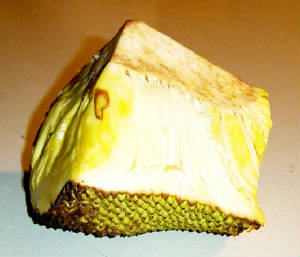
|
| SLICE OF JACKFRUIT |
I'll have a tablespoon or two of lecithin granules with
breakfast, and sometimes Ziggy will grab a beakful. Buddy cannot resist lecithin. We'll also have some
bee pollen. Pollen is a perfect snack--it is extremely nutritious
and it's sweet; Ziggy loves it. I eat so much that I have to buy
it several pounds at a time. One caveat regarding pollen: although the percentage varies with species of plant from which
it is derived, pollen IS a sweet, a sugar. It's in the neighborhood of 40% sugars, so, regardless of how "healthy" the rest
of it is, keep that in mind.
Ignore all the wacko nonsense you may have heard about bee pollen; all kinds of claims get made
for it, especially among "health" food fanatics. Usually these claims tout the supposed nutritional composition
of "bee pollen" as if it were a single substance. The fact is that every
single kind of pollen is different because the plants the pollens come from are different; the amino acid and
other component profiles vary wildly.
I mentioned fruit.
We are always going to be snacking on fruit throughout the day. Because Houston is such a large port city and is so ethnically
diverse, the variety of available uncommon foods is stunning. Sure, we eat bananas, but I prefer colored
fruits, for variety's sake and for antioxidant content.
| MAMEY |
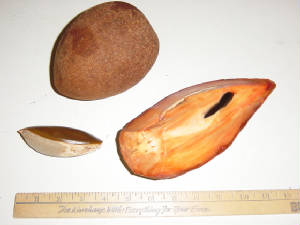
|
| WHOLE FRUIT, SEED AND CUT FRUIT |
Ziggy and I both love mamey sapote [pictured,
left], a fruit most Americans have never heard of. Even where I usually buy it--at a store that caters
to ethnic minorities--most cashiers don't recognize it, so I added the PLU code (4310) to my cell
phone's address book so I can give the code to the cashier during checkout. The fruit's a little costly, $4
a pound last year, now down to $2.29 a pound, but it is still risky to buy, since you never know for sure if it's going
to turn out good, and it may weigh 2 pounds or more. The flesh has the
color of a slightly reddish yam, and tastes almost like sweetened pumpkin. It is absolutely delicious when properly
ripened. If you ever get one, make sure it is completely soft
before eating, otherwise you will regret it. It keeps well in the fridge after it's softened, but don't
store it in the fridge first. The fruit we get here rarely ripens properly all the way through. Don't taste the
unripened sections of pulp; they are mouth puckering.
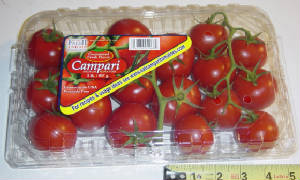
|
| CAMPARI TOMATOES |
We might have a small tomato also; if he's not in the
mood for tomato, I'll leave one in his "wet" cup. The ones you see in the picture [left] are Camparis, sometimes
available at Sam's Club, Kroger and Safeway/Randall's. They cost a little more than regular tomatoes but are pesticide
free and pleasantly sweet; they are the perfect size, about the same as a medium Roma. The shock is that they'll last
a couple of weeks at room temperature. Ziggy will eat as much as a fourth of one. With virtually no sodium or
fat, and lots of vitamins, how can you go wrong? Visit the Campari website for info.
Then he helps me eat breakfast--usually our porridge
or my special omelet (see recipes). Occasionally, we'll have regular cereal or an egg sunny side up with grits.
In the evenings, we usually have some kind of melon before bed.
I have always been such a great fan of watermelon that I would have some at least every 2 or 3 decades, but when I discovered
that Ziggy loves the seeds--moist and fresh, not dried--as well as the juice, I had to start buying them for him.
Sometimes only the seedless is available, so I save extra seeds from seeded ones and freeze them in order
to "spike" the seedless ones later on. Ziggy also loves cantaloupe and honeydew. Only rarely will he eat
those seeds, but he loves to guzzle their juice out of a spoon. He likes Korean melon, which can be found at oriental
supermarkets. It looks like a cross between a cucumber and a yellow squash, and, although the seeds are extremely
tiny, Ziggy and Buddy both go crazy for them.
I've discovered that there's a huge difference in different
grades of melon. Low quality cantaloupe reminds me of paint thinner or turpentine, but US grade A cantaloupes
are usually delicious, and have an almost cinnamon-like flavor. Sam's Club has excellent melons.
| DRAGONFRUIT |
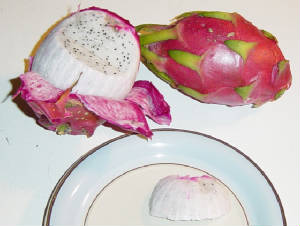
|
| ACTUALLY THE FRUIT OF A CACTUS |
| GOLDENBERRIES |
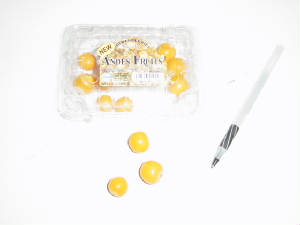
|
| A RARE TREAT FROM THE ANDES |
|
 |
|
|
 |
|
|
 |
|
|
 |
 |
 |
|
|
This is a personal web site, not a business. If you find
any of the information here useful, please consider a donation. Help keep Ziggy the most spoiled parrot in North America!
Thanks.
All content on this site, including pictures, is copyrighted,
©2006 through 2016, by George A. Butel. All rights are reserved; text may be quoted
freely with attribution, but critical commentary must give me the opportunity to reply.
|
Visit our hints for cancer patients Google page, which tells you some of the things I learned during cancer treatment, including
a few things that "they" forget to tell you, such as having to be a little bit "anal" about trying to prevent opportunistic
infections. I never had any during my treatment, so I think my obsession paid off.
LEGAL STUFF
This site has tips and observations about dealing with parrots,
and a few of my own views about human and parrot health concerns. I have a degree in biochemistry, so I am qualified to make
some statements about foods, medicines and supplements, but I am neither a veterinarian nor a physician, and I do
not practice human or veterinary medicine. You should certainly double-check any ideas you might get from me, or anything that
you might construe as advice, by consulting with an appropriate legally licensed professional. All content
on this site ©2006 through 2014 by George A. Butel. If you see any typos or any information that you feel is inaccurate
or ambiguous, please contact me by clicking here.
I use some free Google stuff, including their search, on this site, and they now require that their privacy policy be listed:
Google, as a third party vendor, uses cookies to serve ads on your site.
Google's use of the DART cookie enables it to serve ads to your users based on their visit to your sites and other sites on
the Internet.
Users may opt out of the use of the DART cookie by visiting the Google ad and content network privacy policy.
|
|
|
|



